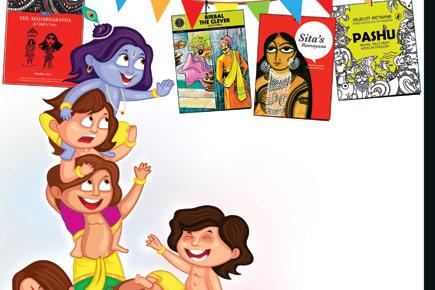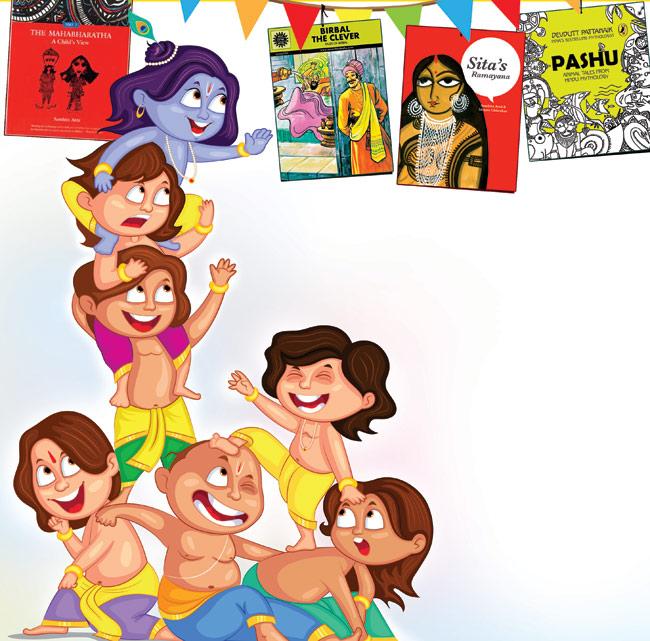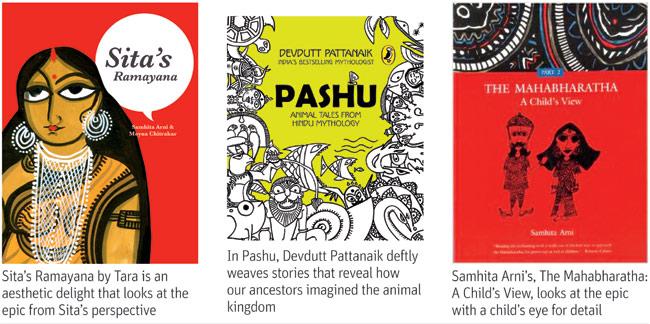Retelling of India’s rich mythology, history and lore is seeing a surge with new authors, publishers, a burgeoning readership and market, and emerging children’s book festivals, paving the way

Sitau00c3u00a2u00c2u0080u00c2u0099s Ramayana, Pashu, The Mahabharatha: A Childu00c3u00a2u00c2u0080u00c2u0099s View
Like many children growing up in urban India in the 1970s and 80s, Enid Blyton and Nancy Drew titles, and Archie comics were our staple reads. Yet, I recall the first Amar Chitra Katha (ACK) I read. The 32-page story was about a young girl who refuses to marry the powerful sun, moon, wind and thunder, and finds happiness with a mouse; turns out she was a mouse herself. I was hooked. To date, I visualise Ram, Sita, Krishna and other characters of Indian mythology as I first saw them in the ACKs.
Since then, Indian writing for children has grown manifold and production value of books has improved significantly. Various genres in children’s writing are seeing a surge, yet the retelling of our epics and mythological tales remains an enduring passion.
ADVERTISEMENT

Tell me an Indian story
Indian epics and mythology span the spectrum of human experience. One can be brave like Arjuna or blinded by love for his son like Dhritrashtra. Family feuds are ‘Mahabharata’ while Ganesh, Bheem and Hanuman make for meal time stories for kids. The love for Indian stories is also reflected in the success of events like the Bookaroo festival. While global authors also participate here, its success has been the Indian talent. M Venkatesh, founder of Bookaroo and owner of Eureka, children’s bookstore in Delhi, explains, “There is a demand for Indian authors writing for children, especially in the 7-11 age group.” India adds 17 million children every year. Sudeshna Shome Ghosh of Red Turtle reflects, “It is essential to be as inclusive as possible, tell stories from different viewpoints, and include stories from different cultural milieus.”

Amar Chitra Katha: Leader of the pack
Quality of storytelling
A Google search for the epic Mahabharata (in English) for children throws up at least a hundred versions across publishing houses, with almost 40 being Amar Chitra Kathas. The results for other popular Indian tales like Ramayana, Panchatantra and Jataka Tales are similar. A review of available titles on the epics and other mythological tales reveals that many titles are not well written. They are either didactic, leaning heavily towards a moral value, or the narrative is simply not engaging enough. Likewise, illustrations haven’t kept pace with the quality that children are exposed to in these days of media-overload. Each Disney character, for instance, is an impeccable product put together by conceptual artists, modellers, storyboard designers and animators. Many parents rue that while their kids love the stories in ACKs, the art doesn’t interest them.

When Delhi-born, Hong Kong based Bhakti Mathur, a successful banker and mother of two wanted to tell her children stories from Indian mythology, she could not find anything worthwhile. She says, “There were no resources that were simple to understand and that captured the rich imagery of mythological India, which is integral to these stories. So, I began writing stories in a style that kids would find fun and non-preachy, and collaborated on the illustrations to bring out the imagery that I want my stories to convey.” And thus the Tell Me Amma series was born.
Modernise ‘old’ characters
Manish Purohit of AuthorsUpfront (and ex-Publisher for Disney Publishing, India) points out, “Old stories can be told in a contemporary manner to engage children. Bheem and Hanuman have been retold in a new context — visually and textually.” In the new avatar, nine-year-old Chhota Bheem, modelled after his Pandava namesake, is blessed with extraordinary strength, and loves laddoos that give him a surge of energy. In the New Adventures of Hanuman, as the bad guy-fighting superhero, Hanuman becomes an icon for the young. Both characters have become more real for children who love them.
Competent voice
India also has a rich oral and written tradition. Most retellings, however, do not manage to capture the sophisticated structure of this storytelling tradition. For instance, Panchatantra was written by Vishnusharma to drill sense into three young dissolute princes. Stories from the Panchatantra are multi-layered and full of delicious intrigue, yet most adaptations remain bland moral lessons.
Gita Wolf of Tara Books says, “Myths are not seen as belonging to the past, so it is not accidental that retellings continue to be popular, in whatever form. Having said that, there are few contemporary voices in children’s literature (particularly in English) which are genuinely strong.” She is bang on.
Samhita Arni’s The Mahabharatha — A Child’s View is wonderfully told with a child’s eye for detail. No wonder, her version, published in seven languages, and sold 50,000 copies worldwide. Search for old-new content Devdutt Pattanaik tells mythological tales that haven’t been explored in this space. He explains, “The assumption here is we ‘know everything’ that the ‘old’ stories have to tell. That is human arrogance at work. For the child, old stories are new.” In Pashu, Pattanaik weaves stories that reveal how our ancestors imagined the animal kingdom and the key role animals played in human lives.
Vijay Sampath, CEO of ACK-Media says, “India has a rich trove of storytelling that we haven’t reached a stage at ACK-Media where we need to repeat the stories already told.” Their current Ramayana series “is not a retelling of our 32-page comic, but a 1,200-plus page epic dive into each Kand of the Ramayana. This hasn’t been achieved in comic format, and in few narrative formats in English.”
Sales story
Ventakesh shares, “There is a surge of Indian authors writing for children. If publishers were to market children’s books more aggressively, it would work wonders.” Regular book reviews would be a great help too. “I am not sure if publishers push children's books to reviewers in the media as well as they do for adult books,” he elaborates. Shome Ghosh feels that change can be driven by only the market leader ACK-Media, “...which has not significantly changed its visual medium or writing style for years. Publishers have tried different ways of retelling but the impact in terms of sales numbers continues to be with ACK.”
Where from here?
India-centric themes and stories are gaining ground in India. While Children’s Book Trust, National Book Trust, Pratham, Katha, Tulika and Tara continue to experiment with art styles and formats, Random House, Puffin and Hachette have added new content set in our cultural context. Young Zubaan, Duckbill and Red Turtle are pushing the envelope and seeking content from our historical past.
One hopes that the coming years will see earlier untold stories from mythology, and where people can share stories that their families have held precious for generations. Our authors must create unique formats to tell more robust stories.
 Subscribe today by clicking the link and stay updated with the latest news!" Click here!
Subscribe today by clicking the link and stay updated with the latest news!" Click here!







